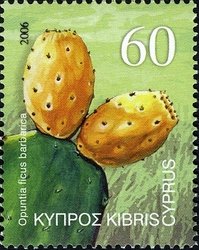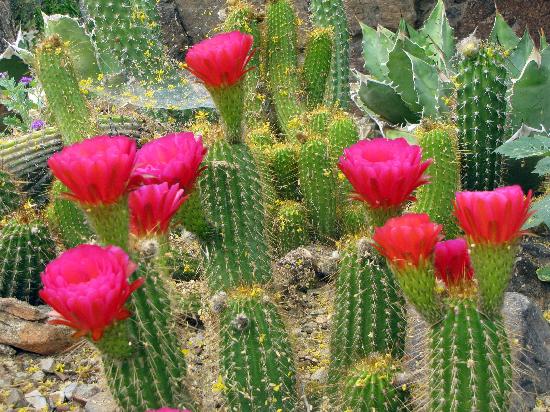Stamp: Opuntia ficus barbarica ("Barbary fig cactus"-prickly pear) (Cyprus 2006)
Opuntia ficus barbarica ("Barbary fig cactus"-prickly pear) (Cyprus 2006)
15 June (Cyprus ) within release Fruits of Cyprus goes into circulation Stamp Opuntia ficus barbarica ("Barbary fig cactus"-prickly pear) face value 60 Cypriot cent
| Stamp Opuntia ficus barbarica ("Barbary fig cactus"-prickly pear) in catalogues | |
|---|---|
| Michel: | Mi:CY 1078 |
| Stanley Gibbons: | Sg:CY 1114 |
Stamp is vertical format.
Also in the issue Fruits of Cyprus:
- Stamp - Elaeagnus angustifolia ("Russian Olive" tree fruit) face value 20;
- Stamp - Mespilus germanica (common medlar tree fruit) face value 25;
- Stamp - Opuntia ficus barbarica ("Barbary fig cactus"-prickly pear) face value 60;
Stamp Opuntia ficus barbarica ("Barbary fig cactus"-prickly pear) it reflects the thematic directions:
In botany, a fruit is the seed-bearing structure in flowering plants (also known as angiosperms) formed from the ovary after flowering. Fruits are the means by which angiosperms disseminate seeds. Edible fruits, in particular, have propagated with the movements of humans and animals in a symbiotic relationship as a means for seed dispersal and nutrition; in fact, humans and many animals have become dependent on fruits as a source of food. Accordingly, fruits account for a substantial fraction of the world's agricultural output, and some (such as the apple and the pomegranate) have acquired extensive cultural and symbolic meanings. In common language usage, "fruit" normally means the fleshy seed-associated structures of a plant that are sweet or sour, and edible in the raw state, such as apples, bananas, grapes, lemons, oranges, and strawberries. On the other hand, in botanical usage, "fruit" includes many structures that are not commonly called "fruits", such as bean pods, corn kernels, tomatoes, and wheat grains. The section of a fungus that produces spores is also called a fruiting body.
A cactus (pl.: cacti, cactuses, or less commonly, cactus) is a member of the plant family Cactaceae (/kækˈteɪsi.iː, -ˌaɪ/),[a] a family of the order Caryophyllales comprising about 127 genera with some 1,750 known species.The word cactus derives, through Latin, from the Ancient Greek word κάκτος (káktos), a name originally used by Theophrastus for a spiny plant whose identity is now not certain. Cacti occur in a wide range of shapes and sizes. They are native to the Americas, ranging from Patagonia in the south to parts of western Canada in the north, with the exception of Rhipsalis baccifera, which is also found in Africa and Sri Lanka. Cacti are adapted to live in very dry environments, including the Atacama Desert, one of the driest places on Earth. Because of this, cacti show many adaptations to conserve water. For example, almost all cacti are succulents, meaning they have thickened, fleshy parts adapted to store water. Unlike many other succulents, the stem is the only part of most cacti where this vital process takes place. Most species of cacti have lost true leaves, retaining only spines, which are highly modified leaves. As well as defending against herbivores, spines help prevent water loss by reducing air flow close to the cactus and providing some shade. In the absence of true leaves, cacti's enlarged stems carry out photosynthesis.


